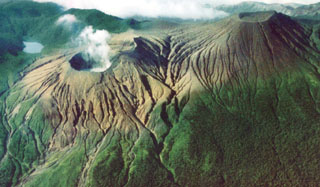Report on Rincon de la Vieja (Costa Rica) — August 1991
Bulletin of the Global Volcanism Network, vol. 16, no. 8 (August 1991)
Managing Editor: Lindsay McClelland.
Rincon de la Vieja (Costa Rica) Explosions eject ash and blocks
Please cite this report as:
Global Volcanism Program, 1991. Report on Rincon de la Vieja (Costa Rica) (McClelland, L., ed.). Bulletin of the Global Volcanism Network, 16:8. Smithsonian Institution. https://doi.org/10.5479/si.GVP.BGVN199108-345020
Rincon de la Vieja
Costa Rica
10.83°N, 85.324°W; summit elev. 1916 m
All times are local (unless otherwise noted)
After reports of strong sulfur odors, geologists visited the summit area on 28-30 August. A sulfurous odor was noted at Copelares on the S flank (1,400 m elevation), during the evening of 28 August. An explosion was heard at 0151 the next morning, followed several seconds later by the sound of falling material. Examination of 29 August records from a seismic station 6 km SW of the crater (RIN3) showed that a small earthquake occurred at 0148:47, then a larger earthquake sequence lasting 7.5 minutes began at 0151:40, coinciding with the first audible explosion. As the ascent continued later that morning, traces of fresh ash were observed beginning at about 1,500 m elevation. Large quantities of ash and blocks, ranging from 15 to 75 cm in diameter, were found deposited in the summit area. Impact craters reached 120 cm in diameter and 35 cm deep.
Bad weather obscured the view of the crater floor, but several explosions were heard, and the largest, at 0930, rained very wet ash on the scientists. Near the crater, the smell of sulfur was very strong, making breathing difficult and stinging the eyes. Nearby vegetation was partially or completely dead. Rain collected at Copelares had a pH of 4.1.
On 30 August, scientists visited Ríos Azul and Pénjamo, which flow down the N flank from the crater area. Both rivers were gray-white with suspended sediment, which was also visible, but in lower concentrations, in the Ríos Colorado and Blanco on the S and SE flanks.
[On 6 September, strong fumarolic activity (jet engine noise) was seen in the active crater. During explosive events of May-August 1991 the ejecta was mainly composed of gray mud (sulfide-rich), lithics, and bread-crust bombs (~10% by volume).]
Geological Summary. Rincón de la Vieja, the largest volcano in NW Costa Rica, is a remote volcanic complex in the Guanacaste Range. The volcano consists of an elongated, arcuate NW-SE-trending ridge constructed within the 15-km-wide early Pleistocene Guachipelín caldera, whose rim is exposed on the south side. Sometimes known as the "Colossus of Guanacaste," it has an estimated volume of 130 km3 and contains at least nine major eruptive centers. Activity has migrated to the SE, where the youngest-looking craters are located. The twin cone of Santa María volcano, the highest peak of the complex, is located at the eastern end of a smaller, 5-km-wide caldera and has a 500-m-wide crater. A Plinian eruption producing the 0.25 km3 Río Blanca tephra about 3,500 years ago was the last major magmatic eruption. All subsequent eruptions, including numerous historical eruptions possibly dating back to the 16th century, have been from the prominent active crater containing a 500-m-wide acid lake located ENE of Von Seebach crater.
Information Contacts: J. Barquero and E. Fernández, OVSICORI; R. Barquero and G. Soto, ICE; Mario Fernández, Héctor Flores, and Sergio Paniagua, Univ. de Costa Rica.

